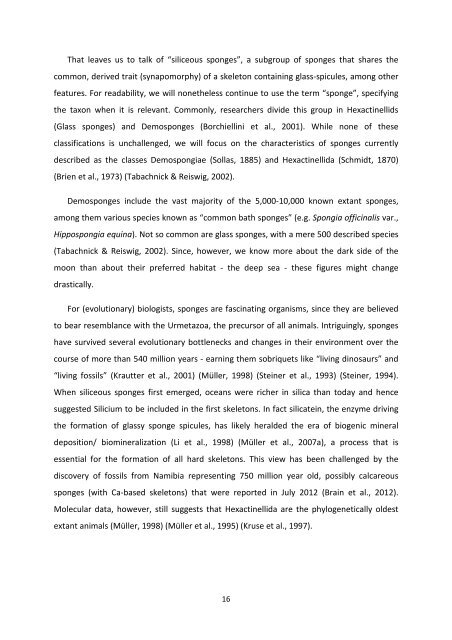MASTER THESIS Biomimetic potential of sponge ... - IAP/TU Wien
MASTER THESIS Biomimetic potential of sponge ... - IAP/TU Wien
MASTER THESIS Biomimetic potential of sponge ... - IAP/TU Wien
Create successful ePaper yourself
Turn your PDF publications into a flip-book with our unique Google optimized e-Paper software.
That leaves us to talk <strong>of</strong> “siliceous <strong>sponge</strong>s”, a subgroup <strong>of</strong> <strong>sponge</strong>s that shares the<br />
common, derived trait (synapomorphy) <strong>of</strong> a skeleton containing glass-spicules, among other<br />
features. For readability, we will nonetheless continue to use the term “<strong>sponge</strong>”, specifying<br />
the taxon when it is relevant. Commonly, researchers divide this group in Hexactinellids<br />
(Glass <strong>sponge</strong>s) and Demo<strong>sponge</strong>s (Borchiellini et al., 2001). While none <strong>of</strong> these<br />
classifications is unchallenged, we will focus on the characteristics <strong>of</strong> <strong>sponge</strong>s currently<br />
described as the classes Demospongiae (Sollas, 1885) and Hexactinellida (Schmidt, 1870)<br />
(Brien et al., 1973) (Tabachnick & Reiswig, 2002).<br />
Demo<strong>sponge</strong>s include the vast majority <strong>of</strong> the 5,000-10,000 known extant <strong>sponge</strong>s,<br />
among them various species known as “common bath <strong>sponge</strong>s” (e.g. Spongia <strong>of</strong>ficinalis var.,<br />
Hippospongia equina). Not so common are glass <strong>sponge</strong>s, with a mere 500 described species<br />
(Tabachnick & Reiswig, 2002). Since, however, we know more about the dark side <strong>of</strong> the<br />
moon than about their preferred habitat - the deep sea - these figures might change<br />
drastically.<br />
For (evolutionary) biologists, <strong>sponge</strong>s are fascinating organisms, since they are believed<br />
to bear resemblance with the Urmetazoa, the precursor <strong>of</strong> all animals. Intriguingly, <strong>sponge</strong>s<br />
have survived several evolutionary bottlenecks and changes in their environment over the<br />
course <strong>of</strong> more than 540 million years - earning them sobriquets like “living dinosaurs” and<br />
“living fossils” (Krautter et al., 2001) (Müller, 1998) (Steiner et al., 1993) (Steiner, 1994).<br />
When siliceous <strong>sponge</strong>s first emerged, oceans were richer in silica than today and hence<br />
suggested Silicium to be included in the first skeletons. In fact silicatein, the enzyme driving<br />
the formation <strong>of</strong> glassy <strong>sponge</strong> spicules, has likely heralded the era <strong>of</strong> biogenic mineral<br />
deposition/ biomineralization (Li et al., 1998) (Müller et al., 2007a), a process that is<br />
essential for the formation <strong>of</strong> all hard skeletons. This view has been challenged by the<br />
discovery <strong>of</strong> fossils from Namibia representing 750 million year old, possibly calcareous<br />
<strong>sponge</strong>s (with Ca-based skeletons) that were reported in July 2012 (Brain et al., 2012).<br />
Molecular data, however, still suggests that Hexactinellida are the phylogenetically oldest<br />
extant animals (Müller, 1998) (Müller et al., 1995) (Kruse et al., 1997).<br />
16

















